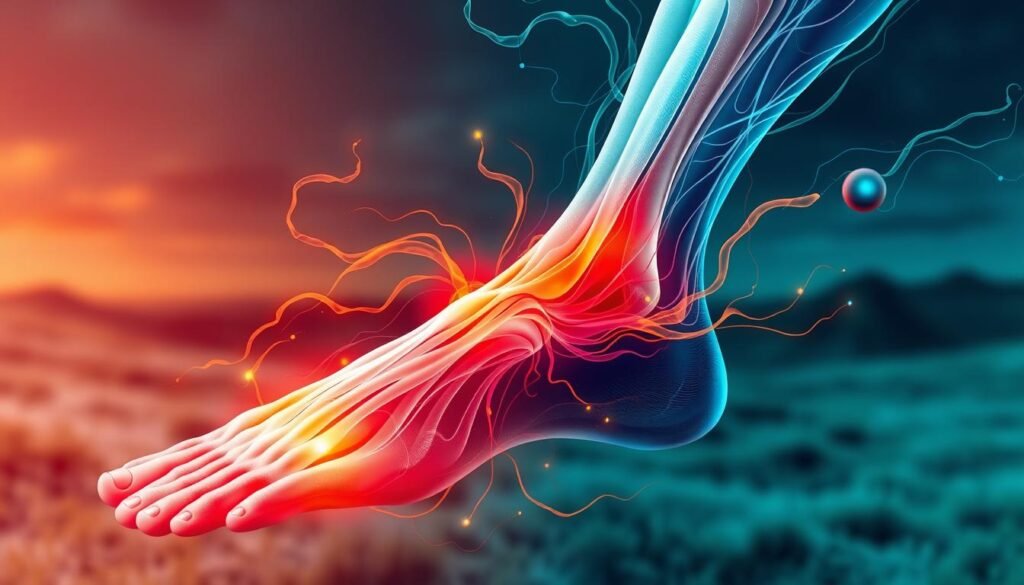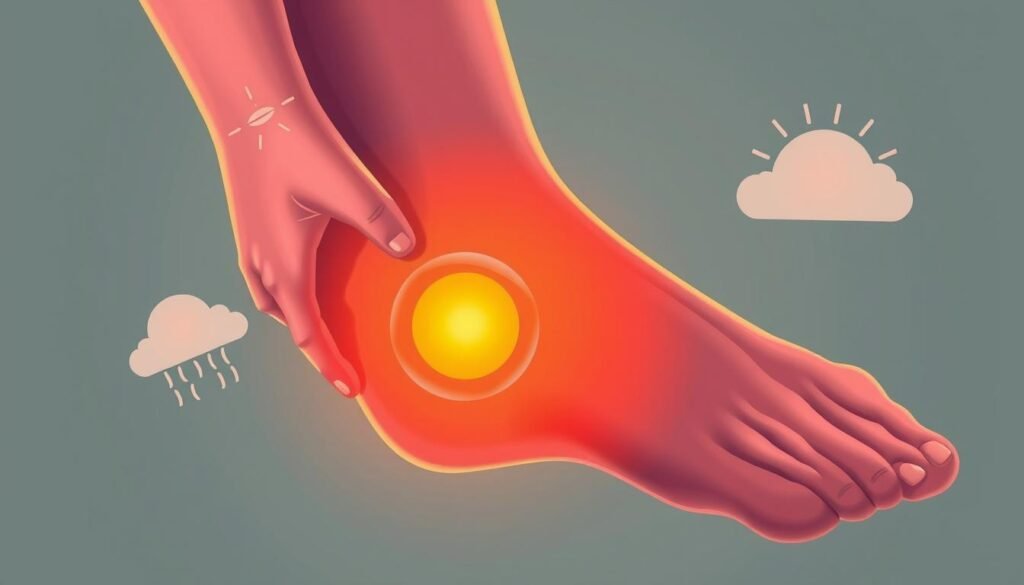Did you know about 30% of adults face chronic leg pain and fatigue? This high number isn’t just from pushing too hard or lifestyle choices. It could point to deeper health issues that need focus. Getting why leg pain and fatigue are linked is key. These signs can show various health problems.
Leg pain and fatigue can really affect everyday life. They can leave people feeling very weak. Many think leg pain and fatigue are just small issues. But, they can be the body’s way of signaling something serious. When these pains keep happening, it’s critical to see what’s causing them.
Understanding that these symptoms are more than just tiredness from a long day matters a lot. Ignoring leg pain and fatigue might cause bigger issues later. So, getting checked by a doctor if these signs stay is crucial. This step allows readers to take charge of their leg health wisely.
Key Takeaways
- Approximately 30% of adults deal with chronic leg pain and fatigue.
- Leg pain and fatigue can signal more serious health issues.
- Understanding the symptoms is essential for effective treatment.
- Ignoring persistent symptoms may lead to complications.
- Medical advice is crucial for long-term leg health.
Understanding Leg Pain and Fatigue
Many people deal with leg pain and fatigue every day. It affects their daily routines and how they enjoy life. It’s important to know when fatigue is just from working hard or when it’s a long-term problem without an obvious cause. Leg fatigue can come from overusing muscles, health issues, or even how we live our lives.
Leg pain can feel like aching, burning, or cramps. Knowing the symptoms helps us understand possible health problems. For example, people with Peripheral Vascular Disease (PVD) might feel their legs are heavy and tired. They might also have numbness. Conditions like arthritis or diabetes can also make leg pain stay around longer.
Being very active can make our legs tired. This happens a lot to people who run or bike. They might need rest to feel better. But if the tiredness doesn’t go away, it’s a good idea to talk to a doctor. They can check if something serious is happening. Not having enough potassium can make you weak, cramp up, or have trouble going to the bathroom.
Some things make tired legs more likely. This includes being pregnant, overweight, or having health issues like diabetes. If you eat healthy and drink plenty of water, it can make your legs feel better. Should the pain stay or get worse, it’s key to get medical advice. A doctor can find the cause and suggest ways to treat it.
Common Causes of Leg Pain
Many people struggle with leg pain from various sources. These include common issues like muscle cramps, injuries, and leg pain causes such as strains. Stress fractures, tendinitis, and shin splints can also cause discomfort. Moreover, conditions like chronic venous insufficiency, due to poor blood flow, add to the pain.
Peripheral artery disease (PAD) affects leg pain, especially with exercise. Deep vein blood clots are painful and may point to more serious health problems. Other leg pain causes are infections, arthritis or gout inflammation, and nerve damage. Damage is often seen in people with diabetes.
Though rare, cancerous bone tumors or sciatica need careful monitoring. It’s vital, especially for those sitting or standing long hours, to watch for leg pain symptoms. Making healthy choices, like eating well, helps avoid nutritional issues leading to pain.
Self-care is key for managing leg pain due to cramps or overuse. Tips include resting the leg, applying cold, and gentle stretching or massage. If the pain continues or if you notice swelling, redness, or alarming signs, see a doctor. They might recommend testing or physical therapy to find and treat the cause.
Discover more about unexplained bruising and tiredness by visiting this resource.
Fatigue in the Legs: What Does It Mean?
Feeling tired in your legs can mean many things. This can go from small issues to big underlying health conditions. Often, overworking and not moving enough can cause leg fatigue. People who are very active might feel their legs are tired after doing a lot of exercise.
Activities like running long distances or biking for a long time can lead to this. You might also get muscle cramps or feel like your legs are heavy. These signs can mean you’ve used your legs too much or you might have a health problem.
One health issue tied to tired legs is chronic venous insufficiency. This makes blood flow in the legs worse and can cause swelling and pain. Also, conditions like varicose veins are common if you’re overweight or your family has had them. About 73% of people have varicose veins globally, with women being more affected.

Peripheral artery disease (PAD) can also lead to leg fatigue. Over 8 million people over 40 in the U.S. have PAD. This condition limits blood flow and makes legs feel tired and crampy. Smoking, high cholesterol, high blood pressure, and diabetes increase your risk. It’s important to know these risks to prevent and manage the condition.
Besides physical activity, things like restless leg syndrome (RLS) could cause tired legs too. People with RLS often feel uncomfortable, especially at night. This makes relaxing hard. Quitting smoking, keeping a healthy weight, and regular exercise can help ease leg fatigue.
If your legs are often tired, don’t ignore it. Doctors can check for underlying health conditions that might need treatment. If you’re always feeling this way, see a healthcare provider for a full check-up.
Connection between Leg Pain and Fatigue
Understanding the link between leg pain and fatigue is important. These symptoms often occur together. They can deeply affect how well we live.
How These Symptoms Interrelate
Leg pain and tiredness can come from many health problems. Things like long periods of sitting, not enough exercise, or wrong shoes can make these worse. Health conditions like fibromyalgia can increase both pain and tiredness. This leads to less activity, which makes the leg pain worse. It’s a harmful cycle that affects everyday life.
Underlying Health Issues
Chronic health issues play a big role in leg pain and feeling tired. For example, peripheral artery disease, related to heart issues, can cause bad blood flow. This leads to leg pain and feeling tired all the time. People with fibromyalgia face constant pain and exhaustion. This makes simple tasks very hard. Sleep problems can also happen, which makes getting better harder. Addressing these health issues with the right medical care is key.

Recognizing Leg Pain Symptoms
Knowing the symptoms of leg pain helps find out the root problems. Different kinds of pain show up in different ways. Spotting these signs early can lead to quick help for serious issues. It’s important to notice other symptoms that come along.
Pain Types and Sensations
Leg pain doesn’t care about your age, and what it feels like can change from person to person. Here are some common types of pain:
- Sharp pain: This is a quick, strong feeling that usually means an immediate injury or condition.
- Dull ache: A continuous, milder pain that could point to something lingering underneath.
- Throbbing discomfort: This kind of pain beats like a drum, often tied to circulation issues.
- Burning sensation: This usually hints at nerve issues, for example, peripheral neuropathy.
When leg pain sticks around, it really affects your life. People who have smoked or have heart issues need to watch their leg pain closely. If your pain feels strange or pops up out of nowhere, seeing a doctor is a smart move.
Accompanying Symptoms
Besides pain, other symptoms could signal bigger health worries. They might be things like:
- Swelling in the legs
- Pain that gets worse and rest doesn’t help
- Skin turning different colors
- Fever
Symptoms like feeling very tired or tender suggest severe conditions like venous hypertension. If foot sores don’t get better after a week, see a foot doctor. Getting advice from professionals leads to the right care. Learning about leg pain symptoms is key to looking after your health well.

Effective Leg Pain Relief Strategies
Looking for ways to ease leg pain is key if you’re hurting. You can mix medical help with home fixes. Checking out different treatments for leg pain is usually the first move.
Treatment Options
Drugs that fight inflammation are often used to treat leg pain. They help lower swelling and ease pain. Physiotherapy is crucial, too, with exercises aimed at strengthening muscles and avoiding new injuries.
For long-term issues, squeezing the leg with special gear can help deal with symptoms.
Home Remedies and Lifestyle Changes
There are simple leg pain remedies to try at home. Warm baths and dry brushing can ease muscle tension and boost blood flow. Staying at a healthy weight and being active also help take the load off your legs.
Eating foods with potassium and antioxidants is good for your muscles. If your pain doesn’t go away or gets worse, it’s smart to talk to a doctor. Especially for those living with chronic issues. For deeper insights, look at this guide on tackling long-term pain.
Leg Pain Exercises for Relief and Strength
Adding effective leg pain exercises to your daily life can really make a difference. These activities improve flexibility and muscle strength. They make moving easier and more comfortable.
Stretching is key for easing muscle tightness that causes leg pain. Here are some important stretches:
- Hamstring Stretch: Hold for 20 seconds and repeat three times to relax the back of your thigh.
- Calf Stretch: Stand against a wall and hold it for 20 to 30 seconds for each leg to help your calves.
- Hip Flexor Stretch: Stay in this position for 30 seconds to ease your hips.
- Sciatic Nerve Pain Relief Exercises: Hold each pose for 30 seconds to reduce nerve pain.
Alongside stretching, building muscle strength is vital. Try leg raises. Lift your leg, hold for five seconds, and repeat. This builds muscle. Tr
Leg Pain Management Techniques
Effectively managing leg pain means using different methods to better your quality of life. Compression therapy and physical therapy stand out. They help reduce discomfort and aid healing.
Compression Therapy
Compression therapy is key for leg pain relief. It uses special socks and sleeves to press on the legs. This lowers swelling and improves blood flow. It’s great for those with chronic venous insufficiency or after surgery. Wearing these garments eases pain, boosts mobility, and fights off tiredness.
Physical Therapy Approaches
Physical therapy gives a custom plan to tackle leg pain. It involves exercises to strengthen muscles and increase flexibility. Therapists work with you to create these routines. They help lessen pain and stop new injuries. Learning about managing leg pain also plays a big part in recovering.
If you have chronic leg pain, see a doctor. Working together is best for a thorough treatment plan. Using both compression and physical therapy helps symptoms and overall health.
Conclusion
This article has shown the strong link between leg pain and tiredness. For example, 67.9% of hairdressers report feeling leg fatigue. It’s clear that understanding and spotting these signs are key. The data also highlight how leg pain varies, showing why detailed check-ups are vital.
Making lifestyle changes, doing special exercises, and getting the right treatments can really improve health. Research shows that how fast we walk and how we train matters. It affects our tiredness and how stiff our knee and hip joints get. This proves the need for personalized care plans.
If you’re dealing with leg pain and tiredness, it’s important to get medical advice. Knowing how to manage these issues can really change your life. By focusing on health, people can break through these challenges. This leads to better movement and a happier life.